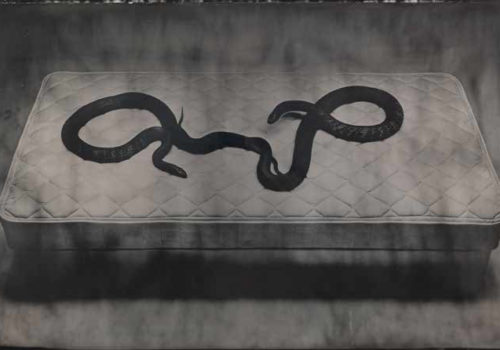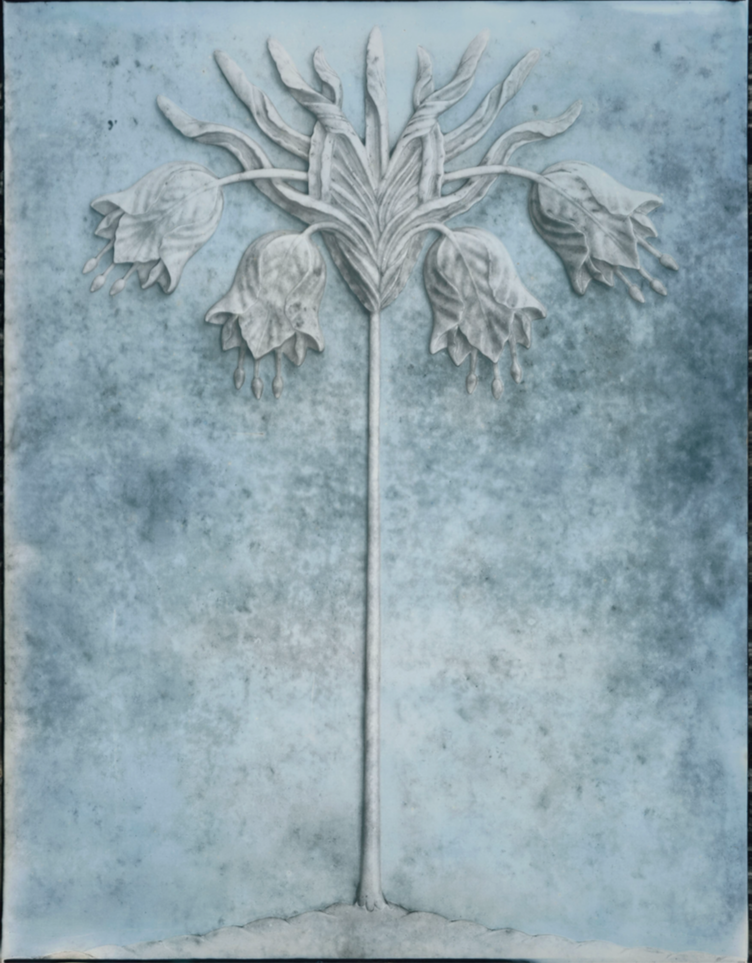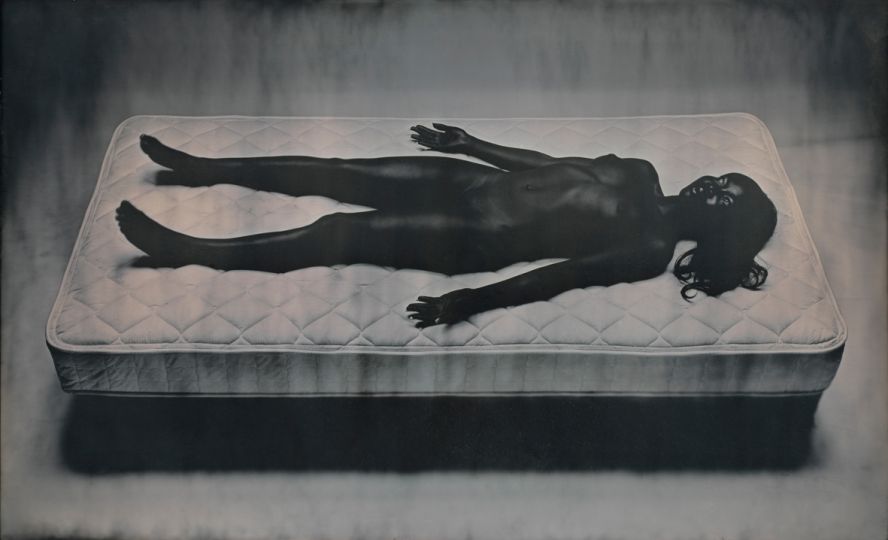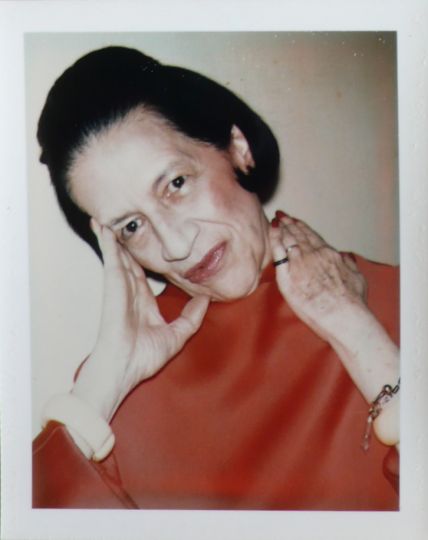Andrea Blanch: During your career, you’ve been labeled a lot of different things — one of them being a “spirit photographer.”
Adam Fuss: Well, spirit photography is photographing manifestations — ghostly-type pictures. I’ve done a lot of work around a series called “My Ghost,” but I never thought of that as being spirit photography.
Andrea : People also compare your work to sun-print photograms, rather than camera-less darkroom techniques.
Adam : I regard any light that illuminates the light-sensitive paper. The kind of light is not important. It’s about the duration and intensity of those different kinds of light and the image that’s desired.
Andrea : You’ve said that your work has more in common with Moholy-Nagy and Man Ray than William Henry Fox Talbot.
Adam : No, it’s the opposite. Just because I use a cameraless technique doesn’t mean I have a lot in common with Man Ray or Moholy-Nagy. It’s because, particularly with Man Ray, the language of what he’s making photograms of is very different from the material I’m choosing and my subject matter — I’m generally choosing natural forms while he’s choosing manmade forms.
Andrea : What do you have more in common with in regards to Henry Fox Talbot and Anna Atkins?
Adam : Talbot and Atkins are using natural forms. I think it’s also in the spirit of experimentation, particularly with Talbot. He is understanding how to make images on the light-sensitive paper that he’s created, and Atkins is formally recording plant material. I feel close to both of their works and that period because it has that sense of wonder and discovery. Man Ray and Moholy-Nagy are much more sophisticated insiders, self-conscious picturemakers.
I’m always trying to make pictures I’m not in.
Andrea : When I met you, I told you that I loved the series where you have snakes on a mattress, and some are in focus and some are not. What is the name of the series?
Adam : “Home and the World.”
Andrea : Have you ever heard of the term “Architecture of Entrance?”
Adam : This is the “Architecture of Entrance” right here. (pointing to picture of a vagina) The beginning of this story is that I made pictures with snakes swimming. What I learned from making this image and observing the snakes is that they are a very kind of positive force of life, both symbolically and energetically — all the snake wants to do is be under its own cognizance, it wants to be free. You get the sense of that cliché, how important freedom is. Years go by after making that image, and I’m thinking about making a picture with snakes that relates to a game I played as a child called “Snakes and Ladders.” This is a Snakes and Ladders board, an old version, because it came to England from India.
I played on an English 1960s version. You play with a die, and you move from here, and on a square that’s a ladder, you go up. If you land on a square that’s a snake, you go down. Each square has an attribution, like this one where that’s a ladder—let’s just pretend that this says “charity,” and that this one with the snake says “greed.” The snake has a negative connotation. Exploring this board game led me into the symbolism of the snake and my own desire to understand why my experience with the snake was highly positive. There is this highly negative, cultural form put on the snake: stories you’ve heard from your parents, and who doesn’t know the story of Adam and Eve? The bad snake! The Medusa? The bad snake! The paradox is that you’re surrounded by good snakes. Every ambulance in New York has a good snake on it. It’s a healing snake. Energy. In this game I played as a child, the first person to reach 100 won.
But in the Indian version, you actually leave the game, and you’re in this Godhead at the top of the game. So it’s about a path towards escaping rebirth; they wanted to achieve enlightenment.
The snake represents a lot of things, but one of them is that it carries the energy that manifests sexual attraction.
It carries the energy of the future of the race. Then look at the shape of your genes. The biggest decision you could make in your life is who you are sharing your genes with, and your decision about who you’re exchanging that with is the most fundamental and dangerous. I think that’s why the snake is dangerous to people. The snake in the game is basically about the process of civilizing that sexual desire and trying to escape from it, trying to transcend sexuality, and, therefore, escape rebirth, escape your karma.
Andrea : Would a lot of people like to do that?
Adam : Apparently not. Monastic attendance is way down.
If you think of the passage of the train from the London Underground, from East London to West London, coming to stations and meeting other train lines — it’s a map of all the sexual experiences of your life. The point where those trains cross symbolizes a moment of exchange, a possibility to move in a new direction. So, the map of the London Underground could be a gene map; it’s like an orgy of genes crossing. It doesn’t have to be sexualized. It could be names, it could be ideas. It could be a map of meeting people and exchanging an idea that produces a new idea, a new invention, a new philosophy. The mattress in this series is symbolic of our world — we’re born on mattresses, we’re conceived on mattresses, and we’ll probably die on mattresses. And then, I thought that I want to photograph people on mattresses, because the snake is symbolic of them. I discovered that my daguerreotype technique wasn’t as good as it could be, because I couldn’t retain the quality of pale-skinned models. Their skin was getting darker; it didn’t make sense. That’s why I decided to shoot African Americans — it doesn’t matter if they go dark. I thought it made sense, because I had this cliché in my head that Eve was from Africa, so that kind of tied in with the snake.
Andrea : And then how did you get to the Medusa, the snakes with the dress?
Adam : The Medusa story seemed inaccessible to me because it’s a feminine story, a woman’s story. Then my life transpired, and I completely got it. This picture is a very important picture for me because my best pictures have nothing to do with me. As soon as my hand, or my selfconsciousness, in on the artmaking process, I’ve limited it.
The best art would be made in a trance, yet the art making process takes part. That’s why Pollock is so great — he lets go before the picture is made. There’s nature between the end of his stick and the canvas. There’s an honesty and universality in it that is very hard to get to with yourself, when the self is making the work. I was looking at the Medusa story and thinking: what the fuck? I don’t even have an entrance to that. What happened was that I was invited to a party, and the theme of the party was Brides and Grooms, so I bought some wedding dresses for my girlfriend, and pretending to be a bride must have tipped her over the edge. It was hell. We were the last of 50-70 couples to arrive. We got back, put the dresses away, and a few months later, I found myself at a breath workshop upstate my wife recommended me to go to. So, I’m in this room with a bunch of people, and these two women were dressed in white. Suddenly the music’s on very loud, and the lights are really dim, and people are doing this breath thing — it was really intense. It was like my head blew off, and I was vomiting, and I was crying, and I was screaming, and it was this heavily cathartic thing. A couple of hours later, I had this thought of putting the snakes in the wedding dress, so I came back to New York and made the picture of the snakes in the wedding dress. I went back and read Medusa, the story we know — the female head decapitated and full of snakes. But there’s the story of how Medusa becomes Medusa: after Medusa’s decapitated, two drops of blood emerge from her decapitation, and when they hit the ground, they give birth to two beings. One is a golden, shining man — that’s how I felt after this cathartic experience. The other thing that comes out of Medusa is Pegasus, which, for me, is the most optimistic image in art, as it speaks to absolute liberation and freedom of emotion.
The image of the dress for me was always the body without the life, it’s a body without a head.
Andrea : Much of your work feels like a dissection, both literally and emotionally. Why is it important for you to combine the technical and the emotional? Technical, meaning that it’s scientific. Your work is experimental, and there’s a spirituality to it.
Adam : Well, photography is technical, so there’s an engagement with the materials and the techniques, the root of how you generate the image. That’s always been interesting and a challenge, but I’m not highly technical, while proper photographers are highly technical because, with commercial photography, you have to really know your stuff to get good and consistent results. I don’t have that kind of brain. I just follow my nose.
Andrea : Why are you attracted to the older methods of creating images?
Adam : I’m not exclusively attracted to them, and I wouldn’t say the photogram is old-fashioned. I would say that as an image-making technique within that medium, it’s ever-present. From Fox Talbot to Adam Fuss, within that history, it’s a substratum. It’s not historical, except the daguerreotype, but I don’t give a shit about that. I’m interested in it as a print medium, because it holds characteristics that are interesting to me.
Andrea : Do you have an interest in digital photography?
Adam : I’m looking into it, thinking about it, exploring it. The reason I got into photograms is because I like its photographic language, which was different than the one that I’d been fed, if you think of images as food. By the time I was 5, I probably had trillions of photographic images, all produced in pretty much the same way, the same conceit. When I reached the age where I wanted to make my own work, I thought: “Fuck that. I don’t want to make images I’ve seen a trillion times; I’m going to try to do something that has a little bit of its own life in it.” No matter how interesting the photographic picture was, it was photographically boring — the syntax, the vocabulary had been used so many times. That led me to the photogram. The daguerreotype is the same story because it’s such a radically different surface, it’s mirror and image at the same time. Symbolically, that really attracted me. The digital presents the same quandary even more, so I’m interested in using the machines to generate images that their creators never thought of. In my last exhibition, there was a whole room of pictures made with digital equipment.
Andrea : Would you say you’re a storyteller? Do you care if people who are viewing your work know about these references or not?
Adam : Well, hopefully these images hold all of this material. You stand in front of it, and you may not get it, but it gets you. It goes into you. It stays there. It’s percolating. Image is my language, but I’ll leave it to the viewers to decide if I’m a storyteller. I think of myself as a picture-maker. I’m still committed to exploring what I can achieve in the digital world.
Andrea : For someone who wants to be a photographer, what would your advice be?
Adam : My advice is not to do it unless you are enamored with it. Look at historical images, identify the images that speak to you and understand why they speak to you; then you can have a dialogue with that. I think that I chose photography because it was the medium I could be removed from — it wasn’t my mark, my hand.
Andrea : Yet, previously, you said that you wouldn’t be satisfied with the images you were making with the machine because your hand wasn’t really in it.
Adam : Well, there has to be something of me in the picture. It’s the nature of the mark — if it’s just me making the mark, then I would define it as an ego mark, which is limiting. If I’m not in the process at all, then there’s no human there. So, it’s that balance. I think the perfect example is Pollock — he is moving the stick exactly where he wants it, and then the paint is moving that 10 to 15 inches between the end of the stick and the canvas. It’s not him, yet he’s directing it. The digital photography machine is designed to do that straightforward, sharp, panoramic image. Everybody can do that, so where’s the individuality in it? I’m trying to put my hand in that, to break that form, in the same way the photogram for me is supposed to break the generic form of the same apparatus. So, for me, it has to be me and my hand.
Andrea : What about people who use digital photography today? Let’s say that their mark is made in post-production.
Adam : That’s an analog photography hybrid. We’re in a historical phase right now, in this transition to a new image world. We actually don’t know where we’re going with photographic images. We just don’t know.
Andrea : Is it disturbing to you in any way? Is there any fear?
Adam : No, when I think about what I’ve done historically, I think I’m a dinosaur. I recognize that analog photography is a historical medium, and I think that anyone working in historical photography is, in a way, irrelevant. The time now is very churned up. There’s this amazing renaissance in analog photography because of the hybridization of the digital and the analog. You can do things that were impossible to do — this hybridization is extraordinary. We’ll go on like that for a while, but where digital imagery is going is not where we are right now. It’s going somewhere else.
Andrea : Will you be involved?
Adam : Well, I’m still here. The program that I set up for myself to make images that I felt were fresh is one that can continue in any photographic medium or time.
Andrea : Well… your themes are universal.
Adam : The problem is I don’t have the vocabulary — I’m not computer literate. It’s sort of like working through other people, which is okay. It’s just different. For me, this began as something I could do alone in the dark room.
My digital world becomes much more collaborative.
Interview Published by Musée Magazine



















